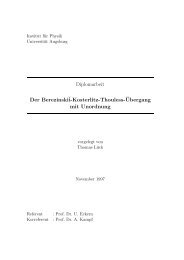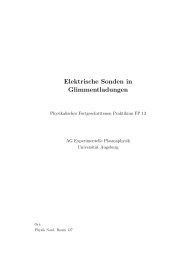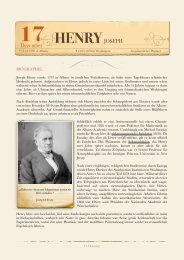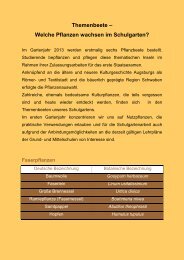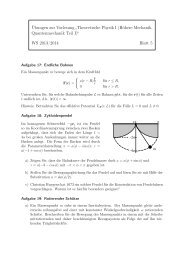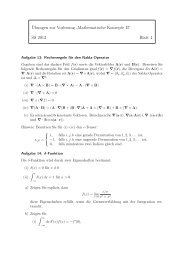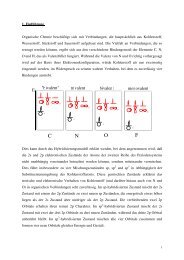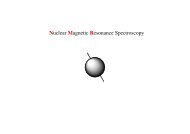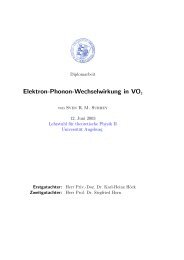PhD Thesis - Universität Augsburg
PhD Thesis - Universität Augsburg
PhD Thesis - Universität Augsburg
You also want an ePaper? Increase the reach of your titles
YUMPU automatically turns print PDFs into web optimized ePapers that Google loves.
36 2. Density-Matrix Renormalization Group<br />
∑<br />
ˆρ E = Tr S |ψ〉〈ψ| = nE ∑<br />
[ψ † ψ] jj ′|j〉〈j ′ | = nE [V D 2 V † ] jj ′|j〉〈j ′ |<br />
jj ′ jj ′<br />
∑<br />
= nE λ 2 µ|v µ 〉〈v µ | = n ∑Sch<br />
λ 2 µ|v µ 〉〈v µ | .<br />
µ=1<br />
µ=1<br />
(2.38b)<br />
So even if system and environment are different, both reduced density matrices have the<br />
same eigenvalue spectrum and hence the same number of nonzero eigenvalues bounded<br />
by the smaller of the dimensions of system and environment. Their eigenvalues are given<br />
by the squared singular values of the state coefficient matrix and the eigenvectors — |u µ 〉<br />
for ˆρ S and |v µ 〉 for ˆρ E — corresponding to nonzero eigenvalues λ 2 µ are the orthonormal<br />
vectors of the Schmidt decomposition (2.37). Therefore the analysis of the reduced density<br />
matrices or the Schmidt decomposition yields exactly the same information. Note that the<br />
columns of U (V ) are the vector representations of the eigenstates of the system-block<br />
(environment-block) reduced density matrix in the basis {|i〉} ({|j〉}).<br />
Now we come back to the original problem of finding a procedure for the optimal reduction<br />
of the system-block state space from the n S -dimensional H S to the m-dimensional<br />
H L(l+1) . If m n Sch , then from (2.37) and (2.38b) it follows that the projection to the subspace<br />
spanned by the system-block reduced density-matrix eigenstates |u µ 〉 with nonzero<br />
eigenvalues λ 2 µ is enough to reduce the Hilbert-space size and to leave the superblock state<br />
|ψ〉 unchanged. What remains is the case when m < n Sch and hence it is not possible to<br />
find a projection which does not alter |ψ〉. In what follows I will provide three different<br />
criteria for determining the optimal reduction procedures, which, as we will see, lead to<br />
the same space-reduction schemes.<br />
(i) Optimization of expectation values [257]: If the superblock is in a pure state |ψ〉<br />
(2.34), the physical state of the system block is fully described through a reduced<br />
density matrix ˆρ S (2.38a).<br />
Consider some bounded operator Ô acting on the system block (‖Ô‖ =<br />
max φ |〈φ|Ô|φ〉/〈φ|φ〉| ≡ c Ô<br />
< ∞). The expectation value of Ô is<br />
〈ψ|Ô|ψ〉<br />
〈Ô〉 = = Tr Sˆρ S Ô (2.39)<br />
〈ψ|ψ〉<br />
that can be expressed in the reduced density-matrix eigenbasis as<br />
n S<br />
〈Ô〉 = ∑<br />
λ 2 µ 〈u µ |Ô|u µ 〉 . (2.40)<br />
µ=1<br />
Now, since we wish to reduce the system-block space size to the m, it is reasonable<br />
to consider a projection onto the subspace spanned by the m dominant eigenvectors<br />
(those with the largest eigenvalues) of the reduced density matrix in order to obtain



